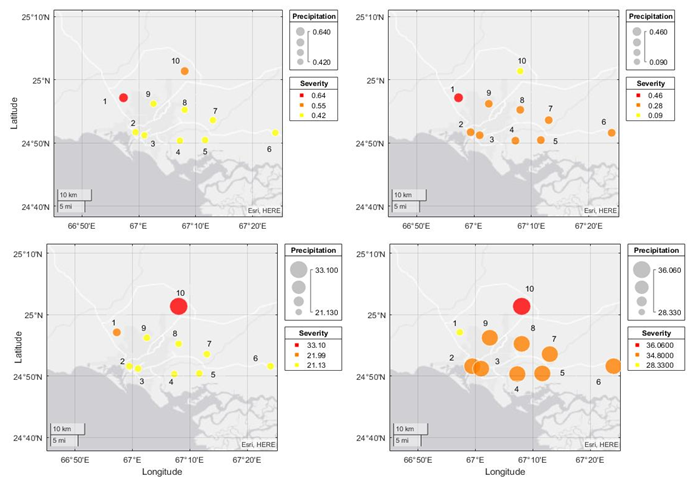Assessing Eight Years of Monsoon Rainfall Patterns in Karachi, Pakistan: Study of the Intense Rainfall Events
Keywords:
Flood inundation, Rainfall, Cumulative rainfall, Monsoon, Precipitation, Linear regression coefficient.Abstract
Rainfall plays a pivotal role in regulating water levels in reservoirs, which can lead to overflow or drought, depending on the unpredictability of rainfall patterns. In 2020 and 2022, Sindh experienced seven episodes of normal to heavy rains, causing flooding and disrupting major highways such as Gwadar-Karachi. This study evaluates daily and cumulative rainfall data in Karachi for the months of June, July, and August from 2016 to 2023. The rainfall data is divided, focusing on the monsoon rains over the eight-year period. Among these years, the highest recorded rainfall of 93.099mm occurred on August 11, 2019, while the lowest rainfall of 0.001mm was noted on July 26, 2016, and June 18, 2017. The yearly (2016-2023) cumulative rainfall for the study period was 114.6mm, 187.0mm, 34.9mm, 310.5mm, 347.9mm, 285.3mm, 761.4mm, and 167.6mm respectively. Notably, the cumulative rainfall and the frequency of rain events were highest in August 2020 and 2022. The monthly data revealed that Karachi experienced exceptionally heavy rainfall in August 2020 and 2022, resulting in significant disruption and chaos in the city. Moreover, when considering the data across the years, it becomes evident that Karachi faced unprecedented rainfall in 2020 compared to the preceding years. This research represents the first comprehensive analysis of the intense rainfall events in August 2020 and 2022 in Karachi. It identifies trends in rainfall patterns that led to flood-like conditions in the city. This study provides a detailed and quantitative understanding of rainfall occurrences during the monsoon season. Such insights are invaluable for assessing flood risks in Karachi, Pakistan.
References
“Evaluating Future Climate Projections in Upper Indus Basin through GFDL-ESM2M Model | International Journal of Innovations in Science & Technology.” Accessed: Nov. 23, 2023. [Online]. Available: https://journal.50sea.com/index.php/IJIST/article/view/553/1079
L. Cochrane, S. C. Lewis, M. M. Engdaw, A. Thornton, and D. J. Welbourne, “Using farmer-based metrics to analyze the amount, seasonality, variability and spatial patterns of rainfall amidst climate change in southern Ethiopia,” J. Arid Environ., vol. 175, p. 104084, Apr. 2020, doi: 10.1016/J.JARIDENV.2019.104084.
“ML/AI Based Flood Mapping in Swat Watershed Using Sentinel-I and Sentinel-II Data.” Accessed: Jun. 06, 2024. [Online]. Available: https://journal.50sea.com/index.php/IJIST/article/view/554/1077
“Python Based Modelling of Flood Damage Assessment Using High-Resolution Aerial Imagery | International Journal of Innovations in Science & Technology.” Accessed: Jun. 06, 2024. [Online]. Available: https://journal.50sea.com/index.php/IJIST/article/view/516/1052
A. Fortelli, N. Scafetta, and A. Mazzarella, “Nowcasting and real-time monitoring of heavy rainfall events inducing flash-floods: an application to Phlegraean area (Central-Southern Italy),” Nat. Hazards, vol. 97, no. 2, pp. 861–889, Jun. 2019, doi: 10.1007/S11069-019-03680-7/METRICS.
C. G. Collier, “Flash flood forecasting: What are the limits of predictability?,” Q. J. R. Meteorol. Soc., vol. 133, no. 622, pp. 3–23, Jan. 2007, doi: 10.1002/QJ.29.
V. F. Loginov, A. A. Volchek, and T. A. Shelest, “Analysis and simulation of rain flood hydrographs in Belarus rivers,” Water Resour., vol. 42, no. 3, pp. 292–301, May 2015, doi: 10.1134/S0097807815030069/METRICS.
M. Abbas, P. A. Carling, J. D. Jansen, and B. S. Al-Saqarat, “Flash-flood hydrology and aquifer-recharge in Wadi Umm Sidr, Eastern Desert, Egypt,” J. Arid Environ., vol. 178, p. 104170, Jul. 2020, doi: 10.1016/J.JARIDENV.2020.104170.
A. M. Elmoustafa, N. Y. Saad, and E. M. Fattouh, “Defining the degree of flood hazard using a hydrodynamic approach, a case study: Wind turbines field at west of Suez Gulf,” Ain Shams Eng. J., vol. 11, no. 3, pp. 741–749, Sep. 2020, doi: 10.1016/J.ASEJ.2019.12.005.
L. Wei, K. heng Hu, and X. dong Hu, “Rainfall occurrence and its relation to flood damage in China from 2000 to 2015,” J. Mt. Sci., vol. 15, no. 11, pp. 2492–2504, Nov. 2018, doi: 10.1007/S11629-018-4931-4/METRICS.
E. A. H. El-Sayed, “Development of synthetic rainfall distribution curves for Sinai area,” Ain Shams Eng. J., vol. 9, no. 4, pp. 1949–1957, Dec. 2018, doi: 10.1016/J.ASEJ.2017.01.010.
J. Zhang, H. Zhang, H. Xiao, H. Fang, Y. Han, and L. Yu, “Effects of rainfall and runoff-yield conditions on runoff,” Ain Shams Eng. J., vol. 12, no. 2, pp. 2111–2116, Jun. 2021, doi: 10.1016/J.ASEJ.2020.10.010.
A. Murumkar et al., “Trends and spatial patterns of 20th century temperature, rainfall and PET in the semi-arid Logone River basin, Sub-Saharan Africa,” J. Arid Environ., vol. 178, p. 104168, Jul. 2020, doi: 10.1016/J.JARIDENV.2020.104168.
R. Tichavský, A. Koutroulis, O. Chalupová, V. Chalupa, and K. Šilhán, “Flash flood reconstruction in the Eastern Mediterranean: Regional tree ring-based chronology and assessment of climate triggers on the island of Crete,” J. Arid Environ., vol. 177, p. 104135, Jun. 2020, doi: 10.1016/J.JARIDENV.2020.104135.
“Assessment of GPM based Integrated Multi-satellite Retrievals (IMERG) Under Diverse Climatic Conditions in Pakistan | Pakistan Journal of Engineering and Applied Sciences.” Accessed: Jun. 06, 2024. [Online]. Available: https://journal.uet.edu.pk/ojs_old/index.php/pjeas/article/view/1182
X. Xu, S. K. Frey, and D. Ma, “Hydrological performance of ERA5 and MERRA-2 precipitation products over the Great Lakes Basin,” J. Hydrol. Reg. Stud., vol. 39, p. 100982, Feb. 2022, doi: 10.1016/J.EJRH.2021.100982.

Downloads
Published
How to Cite
Issue
Section
License
Copyright (c) 2024 50SEA

This work is licensed under a Creative Commons Attribution 4.0 International License.




















